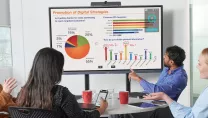Today's education landscape is rapidly evolving - and technology is playing an increasingly vital role, with 64% of schools now using tech to shape the way students learn and the way teachers teach.
Digital whiteboards, also known as interactive touchscreens, classroom screens, or electronic whiteboards have become an important part of modern classrooms. In this blog, we'll explore the top 10 benefits of teaching with digital whiteboards, and shed light on how these devices could help transform your school. Check them out below:
- Enhanced visual learning
Fractions? Algebra? Social Science? We all know some subjects can be a little (or a lot) drier than others, but digital whiteboards can provide a visually engaging way of presenting traditionally dull lesson content. They can display immersive media like colourful graphics and videos that can captivate minds – and keep a hold of attention spans.
- Whole-class inclusion
In a blended or hybrid learning environment, digital whiteboards can facilitate the seamless transition between in-person and online teaching and learning. They allow educators to share content, collaborate with students in real-time, and provide interactive exercises. Additionally, these tools promote inclusivity by accommodating various learning styles, offering visual aids, and enabling access to learning materials – no matter where students are learning from.
- Interactivity is key
One of the biggest benefits of classroom screens is their interactivity. Most devices will have touchscreen functionality - with some even allowing for up to 40 simultaneous touch points. Instead of talking at the class for an hour, teachers can make lessons far more engaging by encouraging students to get up and interact directly with content at the classroom screen. Whether it's solving maths problems, playing educational games, or annotating diagrams, interactive features make lessons more participatory and enjoyable.
- Lesson versatility
It goes without saying, but if you want to keep learning fun and engaging no two lessons should be the same. Digital whiteboards can help teachers build a variety of teaching materials and media formats into their lesson planning. Teachers can think about their use of text, images, videos, and web content in new and creative ways and adapt their teaching methods to the needs of each student – we do all learn differently after all!
- Seamless integration
There’s nothing worse than installing a new piece of tech only to find out it doesn’t work you’re your existing systems or software. Electronic whiteboards effortlessly integrate into existing classroom setups, with most models (or at least ours…) are as easy as plug in and go. Software can also be pre-installed that let’s teachers use their legacy lesson plans, so there’s no blockers to their familiar software and resources. This ease of integration reduces the learning curve for educators and ensures a smooth transition to digital teaching.
- Facilitating collaboration
Whether it’s in school, work, or in our personal lives, in today's interconnected world collaboration is a crucial skill. Digital whiteboards enable students to work together on projects, brainstorm ideas, and collectively solve problems. This collaborative environment fosters teamwork and communication skills, and helps to prepare students for later life and the world of work.
- Ease of use
Packed full of intuitive interfaces and user-friendly features, digital whiteboards are designed to be incredibly easy to use in a classroom setting – and what more could you want really? Teachers can quickly navigate through functions by using quick links, create dynamic presentations and build lessons with an array of media with minimal training. Touchscreen technology works in exactly the same way as our smartphones and tablets, making interaction seamless – whether you’re annotating, drawing, or writing content.
Conclusion
Digital whiteboards have and will continue to transform the way lessons are delivered by creating dynamic learning environments. Whether they’re used to enhance content for visual learners, facilitate hybrid learning for whole class inclusion, or to make teaching more interactive, collaborative and engaging, there are numerous benefits for both teachers and students. No matter how much classroom technology changes and evolves in the future, it is clear that classroom screens in their current form are here to stay for the foreseeable.
To find out more about our digital whiteboards or any other audio visual services, please get in touch.





